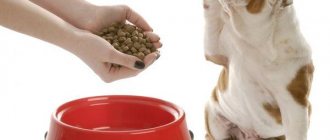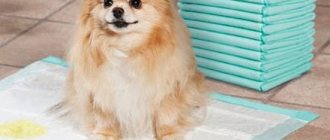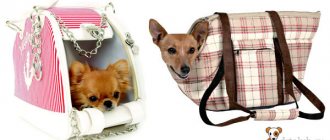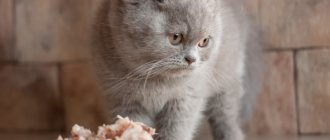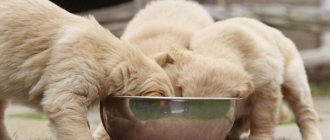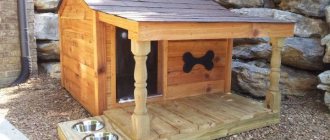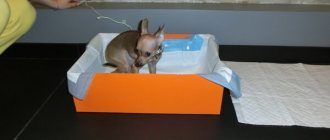The debate about the advantages and disadvantages of ready-made food still continues to this day. There is no clear opinion about which type of nutrition is better. Any diet will have its advantages and disadvantages. But there are times when a pet accustomed to natural porridge has to be transferred to drying. This must be done correctly so as not to cause irreparable harm to the animal’s body.
Why is an animal switched to new dry food?
Each pet is individual, so there are quite a few reasons why your four-legged friend will have to switch to store-bought food.
From another feed
If the animal has already eaten ready-made products, then the main factor in replacing one brand with another is the desire to improve nutrition. Sometimes the owner purchases a more expensive product that contains more useful components or calories.
In some cases, due to a detected disease, a replacement is recommended by a veterinarian. Then the patient can be prescribed a medicinal product that will help normalize health and reduce the burden on the gastrointestinal tract.
For older individuals, large granules are replaced with smaller ones that do not injure their gums and teeth. Typically, elderly pets are given a product labeled Senior.
From natural nutrition
The natural menu has a number of advantages, but it also has a lot of disadvantages. First of all, preparing balanced meals will require a lot of time, which not every person has. It is not always possible to purchase quality products (especially meat) to feed your dog.
Beginning owners lack experience in creating a varied and correct menu. Therefore, at the first opportunity, they try to switch the puppy to dry feeding. And some pets need a specialized diet, which is very difficult to adhere to due to the complex ratio of components.
Ready-made granules are also indispensable during long trips, when it is quite difficult to find fresh ingredients for porridge or soup. If an animal often accompanies its owner on trips, it is better to accustom it to drying.
How to switch a dog to dry food from natural
Veterinarians note that the correct selection of the product and the owner’s patience are the main components of success when transferring a dog from natural food to dry food.
Procedure
You cannot suddenly transfer a pet from one type of menu to another. This is dangerous not only for the digestive system, but for the emotional state. The pet does not understand what is happening and why the contents of the plate that are familiar to him are changing.
Veterinarians recommend following a certain scheme that will help make the transition more gentle:
- The best way to introduce your dog to “drying” is to offer him a couple of granules as a treat from the palm of your hand.
- For the first 3-5 days, it is recommended to use only a quarter of the purchased granules; the rest of the diet remains natural.
- Over the next 3 days, you need to bring the content of the industrial mixture in the bowl to half.
- On days 10-14, “drying” will make up 100% of the pet’s menu.
It is important to remember that you cannot mix fresh and prepared ingredients in the same plate. This is allowed only if the four-legged dog categorically refuses to try store-bought pellets. To get accustomed to the smell and taste of new food, “drying” is added to the porridge, gradually increasing its concentration and removing natural ingredients from the menu.
After a complete transition to food, you must ensure that the portion sizes correspond to those recommended on the packaging. In cool weather, outdoors and indoors, pour 10% more than the specified amount into the bowl. In hot weather, the portion is slightly reduced.
If the animal refuses to “dry”
There are times when an animal accustomed to meat does not agree to other food. Then experienced breeders recommend changing the brand of the mixture to a more expensive analogue, which contains more natural ingredients familiar to the dog.
You can try buying a package with a different flavor if you are more picky. You may have to try more than one option, and then the process may take longer. But the huge assortment in pet stores will ultimately allow you to choose something that your four-legged friend will like.
Sometimes a trick helps - wet canned food is used as an intermediate option. They help the dog realize that not only meat is tasty and aromatic. But this method also has a disadvantage: subsequently you will have to try to transfer your pet from wet food to dry food.
How much water does a dog need?
When trying to switch your pet from natural food to dry food, it is worth knowing how much water the dog needs. The standard rate for calculation is 50 ml of liquid per 1 kg of body weight. If the food consists only of dry granules, then this amount is increased to 100 ml.
An important condition that must be observed is the provision of clean water around the clock. For the first 2 weeks after the transition, it is recommended to ensure that the dog drinks after each meal.
The pros and cons of a natural diet and feeding with ready-made food are still being debated. The owner makes the decision on the type of food. If for some reason you need to replace regular products, it is recommended to do this gradually, in compliance with all the rules.
How to switch your dog to another dry food
Sometimes the usual store-bought mixtures no longer appeal to picky eaters or cause eating disorders in the form of allergies or constipation. Then the owner thinks about changing the dry product.
The transition from one product to another should not be abrupt. Here, just as with the natural menu, you should act in stages:
- The first three days - new food is introduced into the usual food in a volume of 25% of the norm.
- On days 4-6, your pet’s bowl should contain equal amounts of familiar and new food.
- Days 7-9 – the share of usual food by this time is no more than 15%.
- By the end of the second week, 100% of the serving volume should come from the new food.
Granules from different manufacturers or brands are mixed in one bowl and only then given to your four-legged friend. During this period, it is important to monitor the dog’s health. Short-term problems with the gastrointestinal tract are a reason not to introduce other foods too quickly. It may be necessary to stretch out the transfer time a little and reduce the percentage of new granules.
If allergies, severe constipation or diarrhea occur, you should abandon the innovation and look for a replacement. It may be worth trying products designed specifically for allergy sufferers or animals with sensitive digestion.
How to switch a puppy to dry food
The digestive organs of babies are not yet able to fully cope with heavy food loads. Therefore, you should be especially careful when switching your puppy to dry food.
Typically, babies begin to watch what their mother eats and taste the contents of the bowl at the age of 3-4 weeks. From this time on, complementary foods can be introduced using granules soaked in water or store-bought pates. This gruel is given gradually, and its volume should be one fifth of that recommended on the package.
For the first time, the owner dips his finger into the prepared pulp and lets the puppy lick it off. You can gently lower his face into the bowl. The remaining food is given to the mother female.
On the next and subsequent days, the portion is increased, making the porridge less liquid. This way the baby will get used to semi-moist food, and then will be happy to eat the store-bought product. A complete switch to granules is recommended by the time the puppy's baby teeth begin to change to permanent ones.
It should be remembered that only premium, super-premium and holistic-class products are suitable for feeding babies. Food should be appropriate for the age of the puppies and not contain large granules.
How to choose food
Serious difficulties may arise with the choice of feed. The main criteria are as follows:
- age;
- size;
- characteristics of the breed.
All dry dog food is divided into several categories. They are characterized by their distinctive features.
Economy class is cheaper than others. Such products are not particularly beneficial; constant feeding causes health problems. In the economy group, natural meat is rarely found in the composition, only by-products of dubious quality.
Important! Veterinarians' advice is to avoid economy class, as it can harm your pet. It is better to leave the dog on natural food instead.
Premium class is considered the most popular. The composition also includes various by-products, but there are also meat ingredients (their share is 25-30%). The main component is rice. Most of the product is manufactured in the EU or the USA; the one produced in Russia is inferior in quality.
Super-premium class is characterized by a balanced composition and includes a large amount of meat. In production, a high-quality by-product is used; the packaging indicates which one it is. The composition does not include flavorings or flavor enhancers. Food in this class can be given safely to an adult dog or puppy.
For puppies it is better to choose premium food
Canvas is considered the best option that can be purchased at a pet store. In its production, only natural meat is used; by-products are not included. It is believed that canvas is suitable for a complete diet. You have to pay for high quality; not everyone can afford it for long-term feeding of the dog.
When to abandon the idea of translation?
Some pets' bodies react poorly to industrially produced food. If changing the brand and monitoring your pet does not help, then it is better to completely abandon the transition to a dry type of food.
Individuals over 5 years old do not respond very well to changing the menu. Their digestive organs have difficulty adapting to new ingredients, so there is a risk of chronic constipation, pancreatitis or other gastrointestinal problems.
Another reason to avoid drying is an allergic reaction. It can be caused by individual components contained in purchased food. In this case, the owner will have to consult a veterinarian and return to the dog’s usual diet.
Useful tips
Few people know that dehydrated pieces of meat in the diet of animals appeared 160 years ago in 1860. There is still debate about the disadvantages and advantages of this product.
Feed selection
Only those owners who purchased economy-class products for their pets could have a clearly negative opinion about industrial food. It contains components that are useless for regular consumption: soy, cereals, offal instead of meat. The attractive aroma of the lumps is created using chemical flavors and flavor enhancers.
When choosing a product, you should give preference only to high-quality products and a trusted manufacturer. It is important to carefully study the composition on the packaging. The following components should be listed there:
- fresh and dehydrated meat;
- eggs;
- vegetables and fruits, sometimes seaweed;
- fish fat;
- amino acids;
- cereals;
- vitamin and mineral complex.
Eating such granules will not only not harm your pet, but will also bring him benefit and satiation. Super-premium and holistic products do not require additional vitamins and microelements to be added to the menu.
We must not forget about the age and size of the individual. For example, a small breed dog or an elderly individual is unlikely to cope with large pieces of food intended for large breeds of animals.
Drinking regime
When using “drying”, the animal needs constant access to clean drinking water more than ever. It is necessary for the balance of nutrients in the body and normal digestion. Water should be next to the food plate so that your friend can quench his thirst not only after eating, but at any time.
Water and industrial diet for a puppy - important to know!
Having chosen an industrial type of feeding for a puppy, you should make it a rule to ensure that your pet has constant access to a drinking bowl. When feeding dry food, water plays a vital role! When the puppy swallows the granules, they begin to “draw” water into themselves, which provokes acute thirst. The puppy can relieve discomfort and start the digestion process only when he drinks water. The granules will not move into the intestines until they have absorbed enough moisture and become soft.
If you introduce dry food into your pet's diet, make sure that he has several large drinking bowls at his disposal. The water in drinking bowls must be changed at least once a day. During the hot season, deposits quickly form on drinking bowls, so they need to be washed at least 2 times a day.
